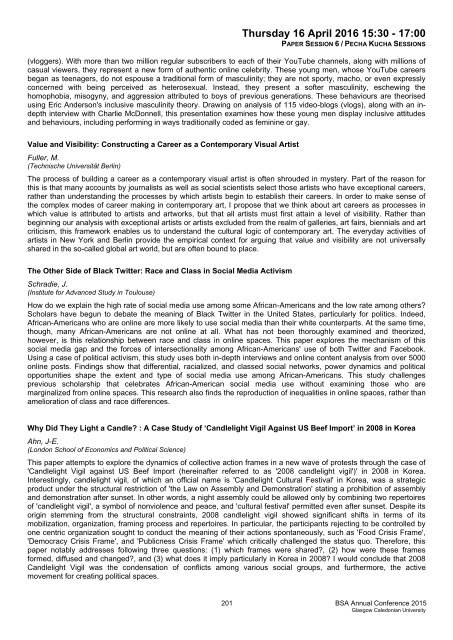Programme full
Programme full
Programme full
Create successful ePaper yourself
Turn your PDF publications into a flip-book with our unique Google optimized e-Paper software.
Thursday 16 April 2016 15:30 - 17:00<br />
PAPER SESSION 6 / PECHA KUCHA SESSIONS<br />
(vloggers). With more than two million regular subscribers to each of their YouTube channels, along with millions of<br />
casual viewers, they represent a new form of authentic online celebrity. These young men, whose YouTube careers<br />
began as teenagers, do not espouse a traditional form of masculinity; they are not sporty, macho, or even expressly<br />
concerned with being perceived as heterosexual. Instead, they present a softer masculinity, eschewing the<br />
homophobia, misogyny, and aggression attributed to boys of previous generations. These behaviours are theorised<br />
using Eric Anderson's inclusive masculinity theory. Drawing on analysis of 115 video-blogs (vlogs), along with an indepth<br />
interview with Charlie McDonnell, this presentation examines how these young men display inclusive attitudes<br />
and behaviours, including performing in ways traditionally coded as feminine or gay.<br />
Value and Visibility: Constructing a Career as a Contemporary Visual Artist<br />
Fuller, M.<br />
(Technische Universität Berlin)<br />
The process of building a career as a contemporary visual artist is often shrouded in mystery. Part of the reason for<br />
this is that many accounts by journalists as well as social scientists select those artists who have exceptional careers,<br />
rather than understanding the processes by which artists begin to establish their careers. In order to make sense of<br />
the complex modes of career making in contemporary art, I propose that we think about art careers as processes in<br />
which value is attributed to artists and artworks, but that all artists must first attain a level of visibility. Rather than<br />
beginning our analysis with exceptional artists or artists excluded from the realm of galleries, art fairs, biennials and art<br />
criticism, this framework enables us to understand the cultural logic of contemporary art. The everyday activities of<br />
artists in New York and Berlin provide the empirical context for arguing that value and visibility are not universally<br />
shared in the so-called global art world, but are often bound to place.<br />
The Other Side of Black Twitter: Race and Class in Social Media Activism<br />
Schradie, J.<br />
(Institute for Advanced Study in Toulouse)<br />
How do we explain the high rate of social media use among some African-Americans and the low rate among others?<br />
Scholars have begun to debate the meaning of Black Twitter in the United States, particularly for politics. Indeed,<br />
African-Americans who are online are more likely to use social media than their white counterparts. At the same time,<br />
though, many African-Americans are not online at all. What has not been thoroughly examined and theorized,<br />
however, is this relationship between race and class in online spaces. This paper explores the mechanism of this<br />
social media gap and the forces of intersectionality among African-Americans' use of both Twitter and Facebook.<br />
Using a case of political activism, this study uses both in-depth interviews and online content analysis from over 5000<br />
online posts. Findings show that differential, racialized, and classed social networks, power dynamics and political<br />
opportunities shape the extent and type of social media use among African-Americans. This study challenges<br />
previous scholarship that celebrates African-American social media use without examining those who are<br />
marginalized from online spaces. This research also finds the reproduction of inequalities in online spaces, rather than<br />
amelioration of class and race differences.<br />
Why Did They Light a Candle? : A Case Study of ‘Candlelight Vigil Against US Beef Import’ in 2008 in Korea<br />
Ahn, J-E.<br />
(London School of Economics and Political Science)<br />
This paper attempts to explore the dynamics of collective action frames in a new wave of protests through the case of<br />
'Candlelight Vigil against US Beef Import (hereinafter referred to as '2008 candlelight vigil')' in 2008 in Korea.<br />
Interestingly, candlelight vigil, of which an official name is 'Candlelight Cultural Festival' in Korea, was a strategic<br />
product under the structural restriction of 'the Law on Assembly and Demonstration' stating a prohibition of assembly<br />
and demonstration after sunset. In other words, a night assembly could be allowed only by combining two repertoires<br />
of 'candlelight vigil', a symbol of nonviolence and peace, and 'cultural festival' permitted even after sunset. Despite its<br />
origin stemming from the structural constraints, 2008 candlelight vigil showed significant shifts in terms of its<br />
mobilization, organization, framing process and repertoires. In particular, the participants rejecting to be controlled by<br />
one centric organization sought to conduct the meaning of their actions spontaneously, such as 'Food Crisis Frame',<br />
'Democracy Crisis Frame', and 'Publicness Crisis Frame' which critically challenged the status quo. Therefore, this<br />
paper notably addresses following three questions: (1) which frames were shared?, (2) how were these frames<br />
formed, diffused and changed?, and (3) what does it imply particularly in Korea in 2008? I would conclude that 2008<br />
Candlelight Vigil was the condensation of conflicts among various social groups, and furthermore, the active<br />
movement for creating political spaces.<br />
201 BSA Annual Conference 2015<br />
Glasgow Caledonian University


